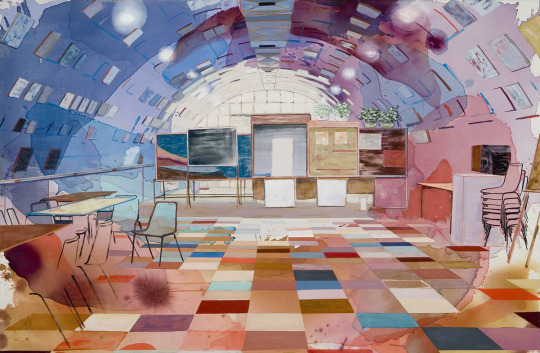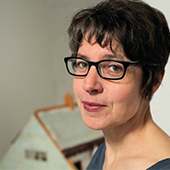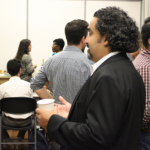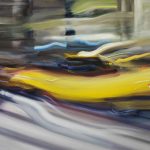Business of Art | Neurodivergent Artists Build Community
“My advice would be to look for each other and look after each other—be generous and share skills.” – Sonia Boué
Imagine a time when neurodiversity is integrated into the art world’s everyday vocabulary. Is this a new concept for you? Neurodiversity stipulates that neurological differences are to be recognized and respected as any other human variation. Increasingly, more and more people—and artists—identify as neurodivergent, or as individuals who diverge from the dominant societal standards of “normal” neurocognitive functioning. These differences can include Dyslexia, Attention Deficit Hyperactivity Disorder, Autistic Spectrum, and others.
Now imagine an average event or opportunity for artists. This may be a networking event that features unstructured conversations, or an open call for funding that requires you to prove a strong network of support. For neurodivergent artists, these ubiquitous realities can present many challenges that often go unseen.
As a way of acknowledging barriers to access and offering solutions, we’ve invited Sonia Boué to share her experiences and recommendations. Boué is a visual multiform autistic artist and a prolific blogger on autism and art. Read her writings here, and visit her website to learn more about her practice. Since being diagnosed as autistic in 2016, Boué created WEBworks, a network and mentoring project funded by Arts Council England based on her own experiences and research. Boué designs projects, mentors, provides training, and consults for arts organizations with the goal of creating opportunity for neurodivergent artists.
Says Boué: “I love my work because it is really varied and I get to work with some seriously talented neurodivergent creatives. Working with organizations is also fascinating and rewarding when you get to see thinking evolve.” Read Boué’s advice for neurodivergent and introverted artists below, as well as arts administrators.
NYFA: You’ve talked about “network ableism” and its impact on you in your quest to fund your projects. Can you tell us more? How do you define ableism in this context?
Sonia Boué (SB): Network ableism in my experience is the assumption that social privilege (ability) is a baseline we all have access to if and when we want it. Because most opportunity in the arts involves some networking, this is a serious access issue for us.
We can’t all summon up a smile and waltz into a room—and there can be many very good reasons why not, some of which may be neurological. For example, dyspraxia, which affects motor coordination and sometimes speech, can make these situations hard to navigate. We may not recognize faces or be able to remember names.
There’s a lot of shaming around not being “socially able” so it takes courage to say it. Decades of not showing up can mean that you don’t understand how conventional networks function. I had to unpick a lot of this to learn how to write a funding bid.
Social assumption also runs through the kind of Arts Council England funding bid I needed to make for my project. Your idea may be brilliant but unless you can find partners to back you (network klaxon!) you will not succeed.
NYFA: You’ve written that when you encounter an ableist comment, you think, “this person needs training – and I (and all my autistic colleagues) hold much of the missing knowledge.” How can institutions work to welcome and incorporate this knowledge?
SB: It’s a brilliant question, and this issue is in the room always. Institutions just aren’t seeing it because of the social stigma involved. So first I think it needs to go on the agenda. Staff will also be autistic, neurodivergent, or introverted.
Then it’s important to invite us in to your organization formally. We are consultants, speakers, and trainers. My view is that we should be paid for our work which is incredibly valuable to arts organizations as we are authentic voices.
But it takes more than a training day! Building trust with community is also very important for any organization; ultimately it’s about relationships. Consider commissioning a review of marketing and events from neurodivergent perspectives.
You can tell a lot about an organization from their use of language. Knowing who you are talking to and getting your message right are an absolute must. Delivering value to community is also essential.
NYFA: Do you have thoughts on how organizations that emphasize in-person events can make them more welcoming to neurodivergent artists?
SB: If you mean networking events, this is a bit like asking a wheelchair user whether they are sure they wouldn’t like to try the stairs just in case! But here are things which can help with in-person events.
Personally, I need people on the inside who know me well, and access to the door. Environment matters greatly; is your building accessible for those with sensory sensitivity? Will your event be noisy, involve crowds, and involve mainly unstructured chats? Tell us!
Information is the name of the game. I advise always publishing clear and detailed information giving a sensory menu for neurodivergent attendees so they can plan for what to expect from the event in terms of challenge.
It’s the genuine thoughtfulness and attention to detail that counts in the welcome. Providing lots of options is also vital. Is there a quiet room with soft furnishing and dim lights, or outdoor spaces? Are there specific structured elements?
Finally, the offer has to be right. If the event holds no interest, I’m not coming. Look into programming with a consultant from the community.
NYFA: Are there resources or voices that you’d especially recommend to arts administrators looking to learn more?
SB: Essentially we are talking about a culture shift in our understanding that humans are neurodiverse beings. Often I’ve found that the adaptations that suit neurodivergent people can benefit us all. This is about increasing options and thinking about individuality.
I recommend these neurodivergent thinkers, bloggers, creatives, and resources:
- Thinking Person’s Guide to Autism
- Autism and Expectations: De-Mystifying Autism
- Dan Holloway, Rogue Interrobang
- Katherine May
- Sonja Zelić
- Kruse on adaptations to environments
- Dr. Kate Fox
- Dr. Damian Milton
- Jon Adams
I don’t particularly recommend sourcing resources from disability arts organizations that aren’t neurodivergent-led. My experience is that the thinking is often not there yet, despite some best efforts.
Personally, I like to be very specific and stick to what I know. I wouldn’t try to advocate for other groups and always try to remember that within neurodivergent groups, there’s probably greater diversity than in the general population.
NYFA: Many artists, for a variety of reasons, feel the typical networking advice is unhelpful or exclusionary. And we ourselves have given this advice! Let’s reframe the conversation: what is some more inclusive and effective networking advice that organizations and artists can begin to share with each other?
SB: I think it’s worth unpicking what some of the difficulties are in quite some detail, as I began to hint earlier. Networking can be hellish if you can’t process language in real-time speed, for example. So this needs an honest and open two-directional approach.
Have you ever been in a room with someone and texted them? I’m sure most of us have. Text slows things right down, and, you can use emojis! Result! Often we’re critical of using technology when we’re face-to-face, but if this could be an adaption, why not?
It’s an exciting time to be breaking through the barriers to invisible disability. What holds us back is often social censure, which is ultimately ableist. Organizations could lead the way in creating a new trend.
If we think about modalities, this is also helpful. How many ways of being in a room and communicating can you think of? I also love the ‘gateway friend’ idea: a known, trusted person who can enable you to get in to a venue and out again.
But we need to understand adaptations to in-person networking are limited in effectiveness because—wash, rinse, repeat—we have to keep it up which is exhausting. Or it just doesn’t work for us. This knowledge puts the onus on change.
NYFA: What are your favorite means of networking online?
SB: Blogging, blogging, blogging! This has been the most effective tool in my entire armory. I also love Twitter. I began with a Facebook artists’ page many years ago, then progressed to a professional platform with the wonderful a-n Blogs.
My WordPress blog has been my most significant online site, far outstripping any other. I’m also warming to Instagram as a more visual platform but have been slower to take it on. I think it’s hard to work across platforms but probably essential.
NYFA: Can you tell us how WEBworks, an autistic-led peer support and mentoring group, came to be? How could this kind of group be replicated by autistic and neurodivergent creatives elsewhere?
SB: WEBworks is unique due to the individuals who’ve formed it. It may provide a transferable model but we can’t yet know that, I feel. It developed from my Arts Council England research into autistic project leadership.
I happened on a mentoring model through my own need to understand the ‘neurotypical’ workplace and then found other artists like me who needed support. Genuine enablement through supported opportunities and specific adaptations are a powerful combination we use.
I now know this to be a responsive and relational approach and will be writing about it in more detail for my Arts Council England project evaluations. I hope to publish some of our findings next year.

NYFA: What are your favorite resources for neurodivergent artists looking to build community or navigate the art world?
SB: There’s no substitute for trawling the internet and I’ve built my entire community by sharing work and spending untold hours in online research. Social media platforms can be game-changing for us, though of course we need ‘realtime’ contacts too.
Often virtual and realtime contact overlaps as relationships deepen. I think the usefulness of contacts and resources could be quite specific in each case. My advice would be to look for each other and look after each other—be generous and share skills.
Even neurodivergent networks can seem distant and closed from the outside. The most effective antidote to professional isolation is to send powerful smoke signals online, from which you can seek out more local neurodivergent contacts. We’re growing in number as we discover identity
Being safe online is an issue I’d like to mention. We can all be taken advantage of, so I would also counsel caution. Take things slowly and allow genuine connection and trust to build up.
Regarding the art world, in the United Kingdom I recommend the wonderfully inclusive online artists network a-n Blogs, whose support has been exceptional including publishing articles about this topic!
Viewing fantastic online art content when you can’t get to many shows provides inspiration and learning. I love to watch the Tate Modern YouTube channel, and I do follow many wonderful U.K. and international artists on Twitter and Instagram, which helps me keep in touch,
But I feel it is vital that neurodivergent artists don’t get dispirited or compare themselves to more neurotypical artists so I watch the scene with a dispassionate eye. I’m interested in building from within and remaining authentic which includes valuing the unique qualities of our neurological status.
NYFA: What has mentorship meant for you, both as a mentee and a mentor?
SB: Trust is at the heart of the mentor/mentee relationship, and it’s a real joy, not to say privilege. I believe such support in an art practice is underrated. We are supposed to know how to navigate an uncertain profession solo.
For myself it has led to professional progression where, despite some early breaks, the complexities of the art world would have thrown me entirely. In many ways it’s about lending experience and gently steering.
Mentoring is a fascinating process because you learn as much as your mentee in many ways. It has allowed me to deepen my understanding of neurodivergent challenge in the arts.
NYFA: You’ve credited successes in your career in part to your “own autistic methods.” Do you have any thoughts on how artists can not only accept their individual differences, but celebrate them?
SB: I really feel we have to embrace a ‘not broken’ philosophy. Some of the artists I work with have acquired huge reservoirs of self-doubt and even despair. Our first job is to realign some of this thinking.
Sometimes it’s my job to sustain hope and provide consistency. Our sensory challenges and issues with executive function can make a practice feel fragmentary until we begin to piece it all together.
The worry that you can never ‘finish’ a piece of work can be quelled if you understand that the process is what interests you most and you can begin to value this. Transformation from ‘failure’ to a more performative practice can take place.
How we frame our creative lives to ourselves really matters. Reconnecting to the source of our creativity—our brains—as valid and useful is incredibly empowering.
– Interview Conducted by Mirielle Clifford, Program Officer, Online Resources

Sonia Boué is an Anglo-Spanish visual artist based in the U.K. She holds degrees in History of Art (BA, Sussex University), and in Applied Social Psychology (MSc, Oxford University). She is also a trained Art Therapist (Sheffield Hallam University). This background informs her research-based multiform art practice, which focuses on themes of exile and displacement, with a particular interest in the Spanish Civil War.
Inspired by the NYFA Source Hotline, #ArtistHotline is an initiative dedicated to creating an ongoing online conversation around the professional side of artistic practice. Our goal is to help artists discover the resources needed, online and off, to develop sustainable careers.
This initiative is supported by the Emily Hall Tremaine Foundation.
Images, from top: Derek Fordjour (Fellow in Painting ’18); Angelina Gualdoni (Fellow in Painting ’08,’15)





